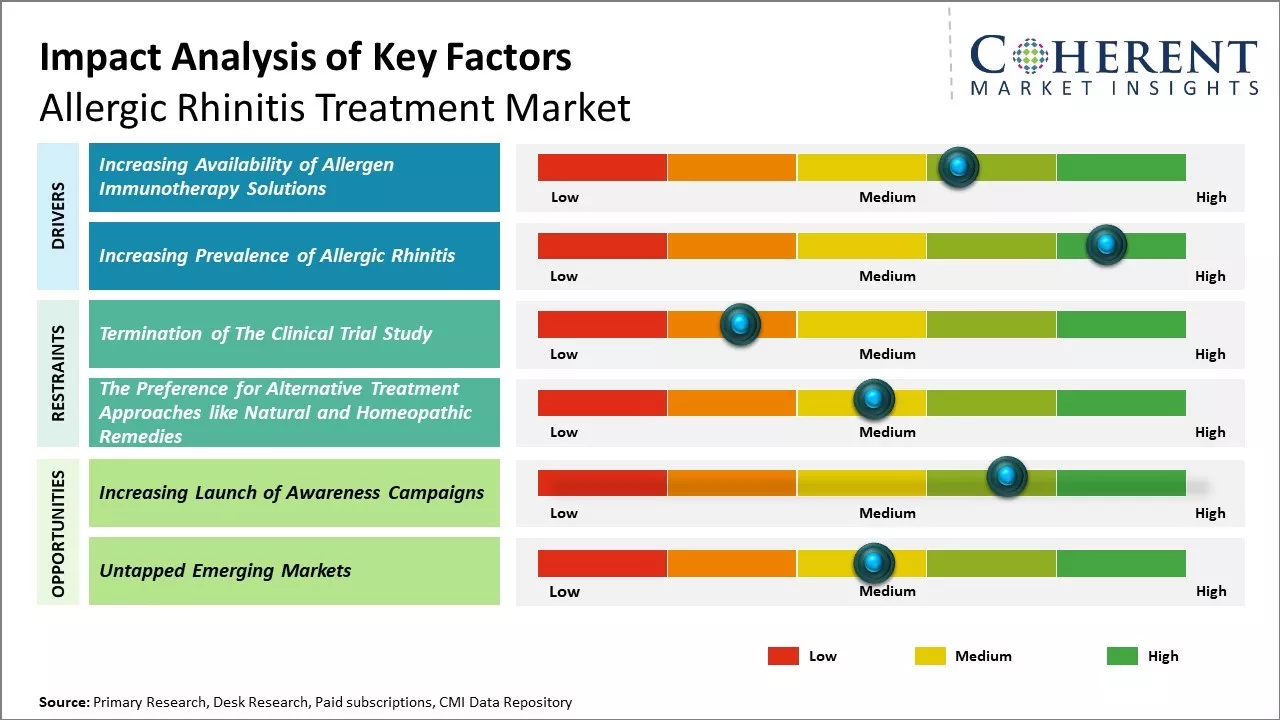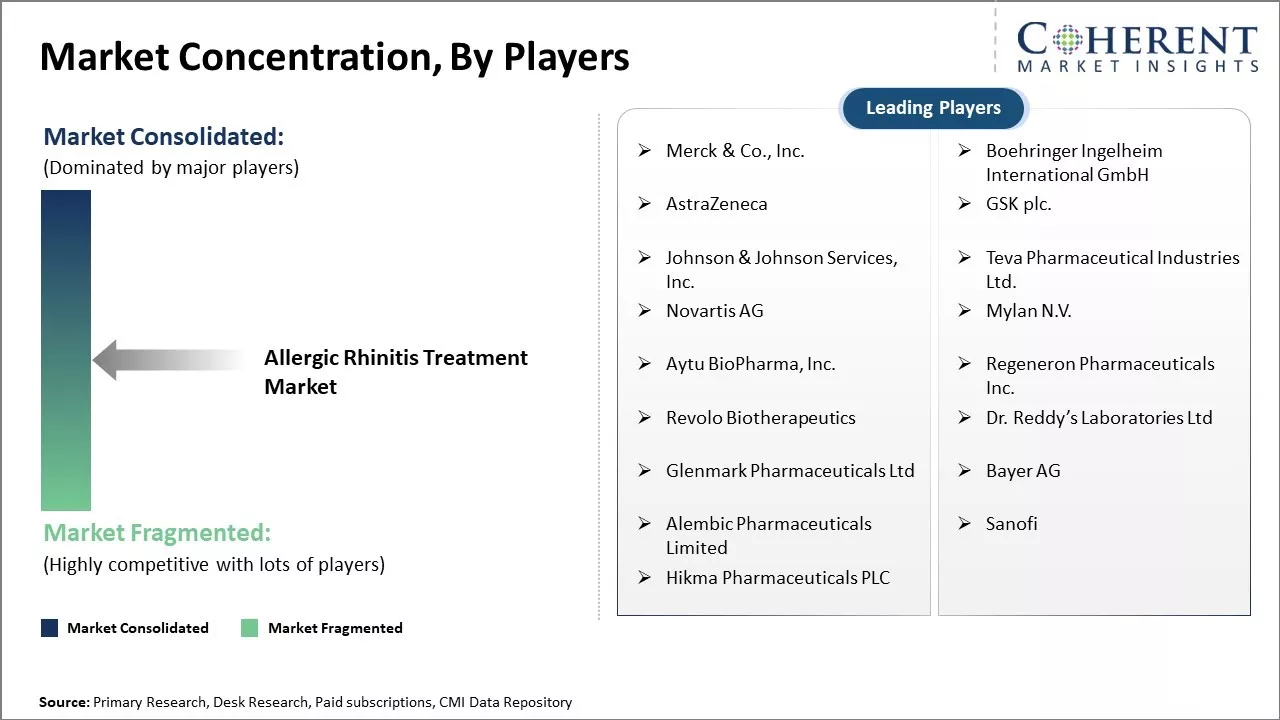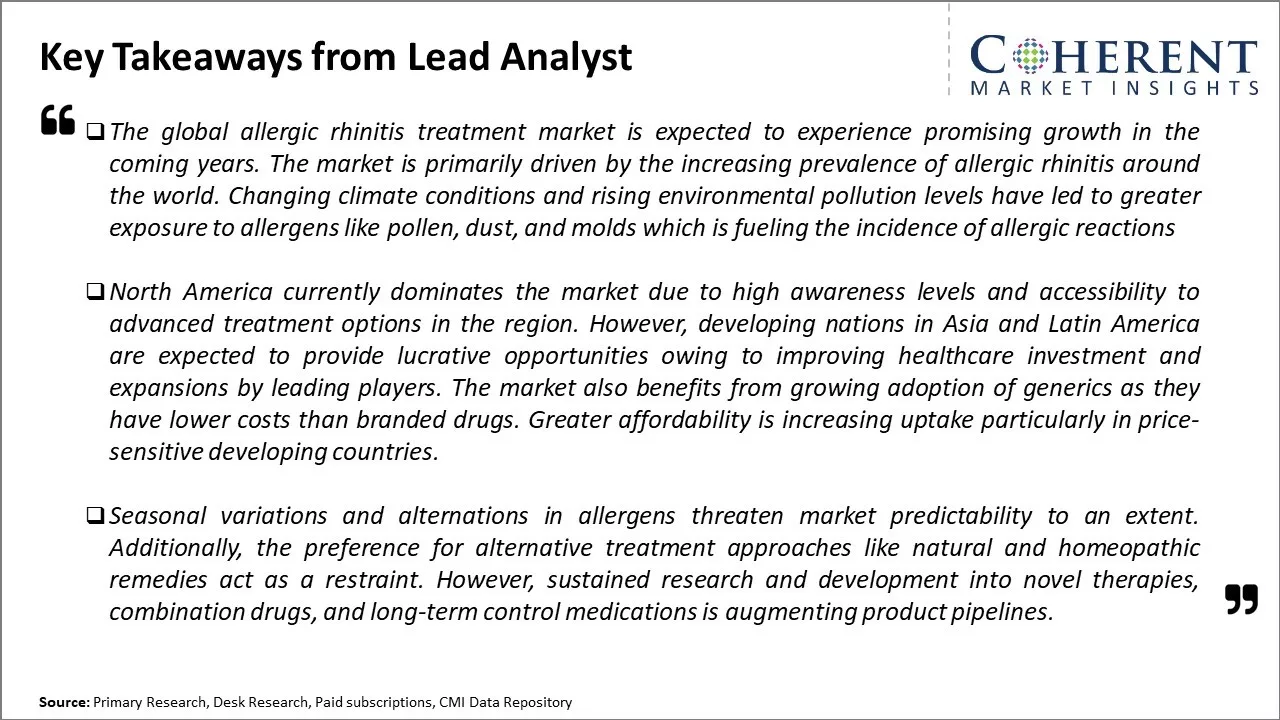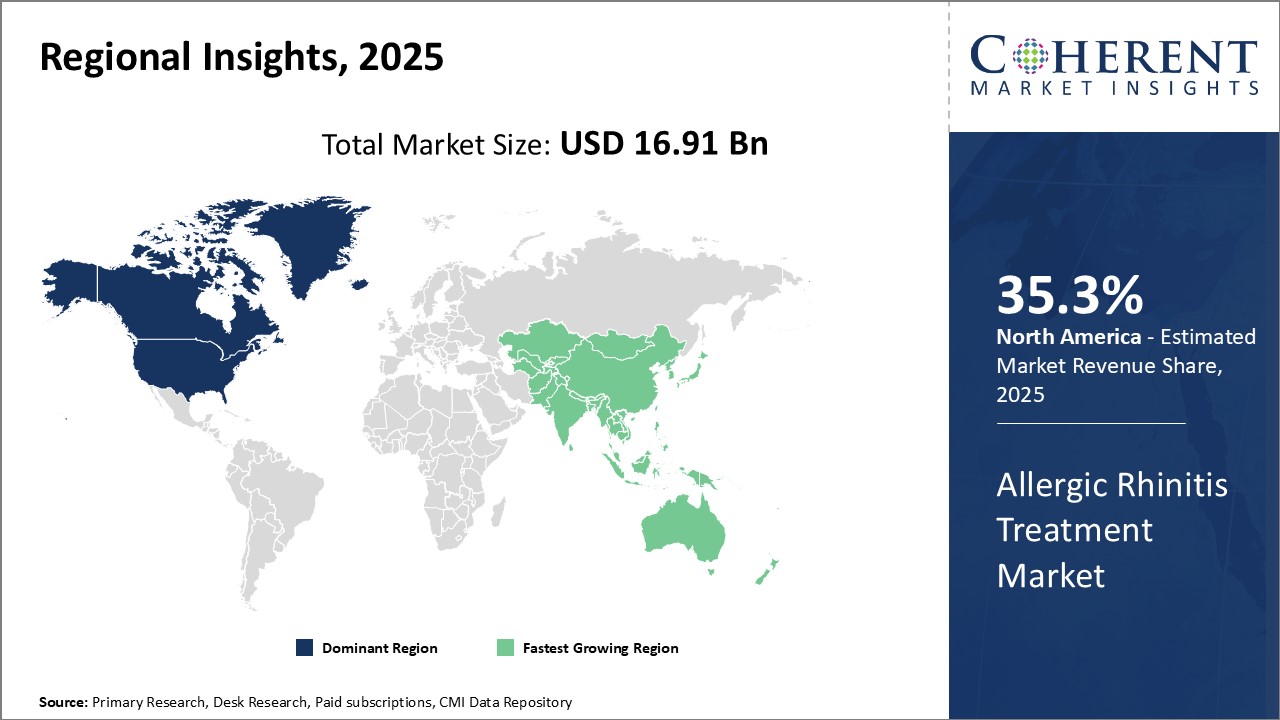The global allergic rhinitis treatment market is estimated to be valued at USD 16.91 Bn in 2025 and is expected to reach USD 23.81 Bn by 2032, exhibiting a compound annual growth rate (CAGR) of 5.0% from 2025 to 2032.

Discover market dynamics shaping the industry: Request sample copy
The growing pollution levels across major cities due to rapid urbanization and industrialization have led to increased instances of allergies and other diseases. Furthermore, the rising patient awareness regarding the availability of various treatment options for allergic rhinitis is also contributing to the market growth. However, the presence of alternative treatment options and expiry of patents of blockbuster drugs may hamper the market growth. Overall, increasing environmental pollution and growing health consciousness among consumers are expected to drive the global allergic rhinitis treatment market growth during the forecast period.
Increasing Availability of Allergen Immunotherapy Solutions
The increasing availability of allergen immunotherapy solutions is one of the factors that is expected to drive the market growth during the forecast period. For instance, in June 2021, Stallergenes Greer, one of the global leaders in allergy immunotherapy, announced that the Alusta, subcutaneous allergen immunotherapy (SCIT) solution for different allergies involving rhinitis, conjunctivitis, rhino conjunctivitis, or asthma is now available in Spain and Italy.

Get actionable strategies to beat competition: Request sample copy
Increasing Prevalence of Allergic RhinitisGrowing industrialization and urbanization have led to higher concentrations of outdoor allergens like pollen, mold, dust, and animal dander in the air. At the same time, people are spending more time indoors where indoor allergens from furnishings, cleaning products, and other materials are present. This has increased individual's exposure and susceptibility to develop allergic rhinitis. Thus, the increasing prevalence of allergic rhinitis boosts the demand for effective treatment which is expected to drive the market growth over the forecast period. For instance, according to the World Allergy Organization report in October 2020, over 400 million people suffer from allergic rhinitis around the world, which to a large extent remains underdiagnosed and undertreated. In the U.S., it affects between 10-30% of the adult general population and up to 40% of children, making it the fifth most common chronic disease.

To learn more about this report, Request sample copy
Market Challenges – Termination of The Clinical Trial StudyThe major factors that are expected to hinder growth of the global allergic rhinitis treatment market include the termination of the clinical trial study. For instance, in November 2022, a clinical trial of Tree MATA MPL or Tree MATA immunotherapy for allergic rhinitis and type I hypersensitivity I was terminated due to poor enrollment of subjects. The clinical trial was sponsored by Allergy Therapeutics, a manufacturer of subcutaneous and sublingual immunotherapy treatments.
Market Opportunities – Increasing Launch of Awareness Campaigns
Increasing adoption of inorganic growth strategies such launch of awareness campaigns by key market players is expected to offer lucrative growth opportunities in the market. For instance, in June 2023, Alkem, a global pharmaceutical company, announced that they had launched "Stop Sneeze to Wheeze" Campaign to Raise Awareness on Allergic Rhinitis and Asthma Coexistence during World Allergy Week 2023. The programme highlights the idea of "One Airway, One Disease" and seeks to increase awareness of the coexistence of allergic rhinitis and asthma.

Discover high revenue pocket segments and roadmap to it: Request sample copy
Insights, By Treatment Type: Targeted Approach of ImmunotherapyThe treatment type segment includes immunotherapy, anti-histamines, decongestants, leukotriene receptor antagonists, corticosteroids, and others. The immunotherapy sub-segment is estimated to hold 31.2% of the market share in 2025 owing to its targeted approach in addressing the root cause of allergic rhinitis. Immunotherapy, also known as desensitization or hypo-sensitization, counteracts the allergic reaction that an individual suffers due to allergens such as pollen, dust mites, and animal dander. Unlike symptomatic treatments like antihistamines that only offer relief from the symptoms, immunotherapy aims to reduce sensitivity to allergens over time and provide long lasting relief. It works by exposing the patient to gradually increasing doses of the allergen(s) that cause their symptoms, in order to induce tolerance. This 'tolerance induction' affords the individual protection against future reactions upon re-exposure to these allergens. As a consequence, patients may find long term reduction or elimination of symptoms on immunotherapy. Its targeted mechanism catering to the cause rather than the symptoms alone has made it the treatment of choice for individuals seeking a long-term solution to their allergic rhinitis.
Insights, By Route of Administration: Various Benefits of Oral Administration Over Other Modes
The route of administration segment includes oral, nasal, intraocular, and others. The oral sub-segment is estimated to hold 44.6% of the market share in 2025 due to the various benefits of oral administration over other modes. Oral medication is the most convenient route for self-administration as tablets or capsules can be taken without needing assistance. This makes adherence to treatment simpler. Additionally, oral drugs typically have higher bioavailability compared to other modes meaning higher amounts of the drug reach the target sites in the body resulting in better efficacy. The avoidance of repeated invasions of the nasal or other mucosa seen with other administration modes also adds to patient comfort with oral drugs. Furthermore, oral drugs usually have lower production and distribution costs compared to other complex drug delivery systems. Together, the convenience, effectiveness, and lower costs associated with the oral route have cemented its status as the preferred administration method for allergic rhinitis treatment.
Insights, By Distribution Channel: Hospital pharmacies control higher market share due to the specialized services offered
The distribution channel segment includes hospital pharmacies, retail pharmacies, and e-commerce. The hospital pharmacies sub-segment is estimated to hold 58.3% of the market share in 2025 owing to the specialized services they provide. As healthcare experts, hospital pharmacists are well-versed in allergy management and able to offer specialized guidance to patients. They ensure each patient receives tailor-made treatment best suited to their condition and lifestyle. Patients regularly visiting hospitals also benefit from continuity of care as all their treatment needs can be addressed under one roof. Hospital pharmacies also stock a wider range of medications including specialty drugs for complex cases. This enables more comprehensive management of allergic rhinitis. The oversight of hospital staff further helps address any drug-related issues timeously. The specialized know-how and integrated services preferentially drive customers to hospital pharmacies over other channels for their allergic rhinitis treatment needs.

Need a Different Region or Segment? Customize now
North America remains the dominant region in the global allergic rhinitis treatment market and is estimated to hold 35.3% of the market share in 2025 owing to its developed healthcare infrastructure and strong presence of leading pharmaceutical manufacturers in the U.S. With awareness among consumers regarding allergy diagnosis and management being fairly high, there is a considerable demand for prescription and over-the-counter medication options across major countries in the region. Furthermore, the presence of several well-established contract research organizations (CROs) and research universities encourages clinical trials for new drug formulations.
Asia Pacific is poised to be the fastest growing region owing to rising environmental pollution levels and changing lifestyle patterns in densely populated nations like India and China. This has significantly increased the prevalence of allergic reactions among general population. At the same time, improving access to private and public healthcare along with increasing spending on specialty medicines is fueling market revenue growth. While pricing of branded drugs remains relatively high in the region compared to generics, industry players are actively focusing on affordable product offerings to tap rising demand from the massive patient pool. Partnerships with local pharmaceutical companies have also enabled global vendors to strengthen supply chain and distribution networks across emerging Asia Pacific countries.
Allergic Rhinitis Treatment Market Report Coverage
| Report Coverage | Details | ||
|---|---|---|---|
| Base Year: | 2024 | Market Size in 2025: | USD 16.91 Bn |
| Historical Data for: | 2020 To 2024 | Forecast Period: | 2025 To 2032 |
| Forecast Period 2025 to 2032 CAGR: | 5.0% | 2032 Value Projection: | USD 23.81 Bn |
| Geographies covered: |
|
||
| Segments covered: |
|
||
| Companies covered: |
Merck & Co., Inc., Boehringer Ingelheim International GmbH, AstraZeneca, GSK plc., Johnson & Johnson Services, Inc., Teva Pharmaceutical Industries Ltd., Novartis AG, Mylan N.V., Aytu BioPharma, Inc., Regeneron Pharmaceuticals Inc., Revolo Biotherapeutics, Dr. Reddy’s Laboratories Ltd, Glenmark Pharmaceuticals Ltd, Bayer AG, Alembic Pharmaceuticals Limited, Sanofi, and Hikma Pharmaceuticals PLC |
||
| Growth Drivers: |
|
||
| Restraints & Challenges: |
|
||
Uncover macros and micros vetted on 75+ parameters: Get instant access to report
*Definition: Allergic rhinitis also called as hay fever, is an inflammation of the inside of the nose due to an allergic reaction to tiny particles in the air called allergens. Allergic rhinitis is also called cold-like symptoms because the symptoms resemble to cold symptoms such as sneezing, itchiness, blocked or runny nose, etc. The immune system reacts to a particular type of allergen, which causes allergic rhinitis. This reaction releases a different number of chemicals inside of mucous membrane of the nose due to which the nose becomes swollen and forms an excessive amount of mucus. Various allergens that cause allergic rhinitis include pollen, spores, house dust mites, flakes of skin, or droplets of saliva or urine from a certain animal. When allergic rhinitis is caused by pollen, it is called hay fever.
Share
Share
About Author
Ghanshyam Shrivastava - With over 20 years of experience in the management consulting and research, Ghanshyam Shrivastava serves as a Principal Consultant, bringing extensive expertise in biologics and biosimilars. His primary expertise lies in areas such as market entry and expansion strategy, competitive intelligence, and strategic transformation across diversified portfolio of various drugs used for different therapeutic category and APIs. He excels at identifying key challenges faced by clients and providing robust solutions to enhance their strategic decision-making capabilities. His comprehensive understanding of the market ensures valuable contributions to research reports and business decisions.
Ghanshyam is a sought-after speaker at industry conferences and contributes to various publications on pharma industry.
Missing comfort of reading report in your local language? Find your preferred language :
Transform your Strategy with Exclusive Trending Reports :
Frequently Asked Questions
Joining thousands of companies around the world committed to making the Excellent Business Solutions.
View All Our Clients
US Reciprocal Tax Impact Analysis On Allergic Rhinitis Treatment Market
Stay updated on tariff changes with expert insights and timely information